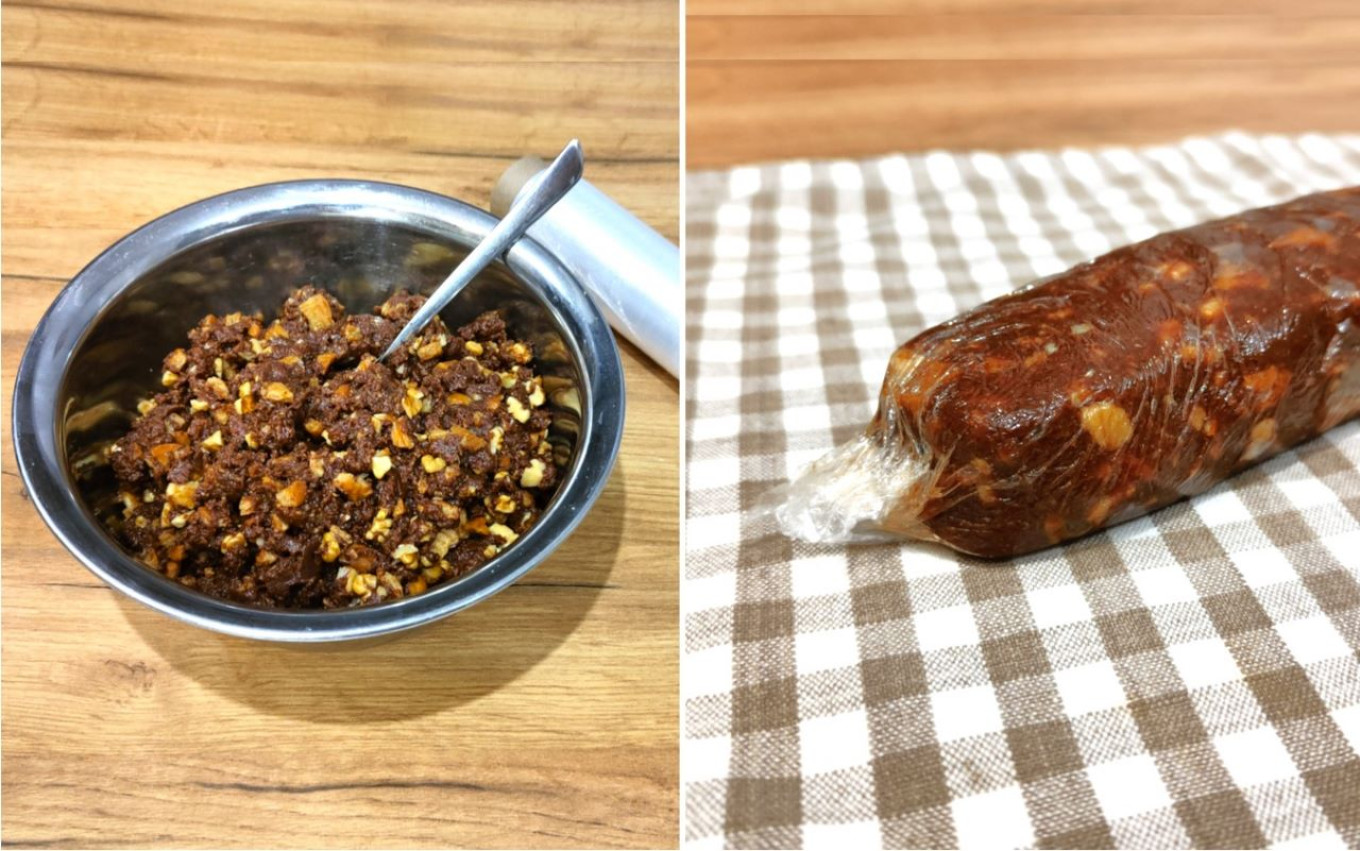Creamy, chocolatey logs made from cookies, cocoa, and butter were on the table in almost every Soviet family. Despite their foreign origins, they became one of the most common homemade desserts. And they became a kind of symbol of socialism — both its heyday and its decline.
“Do you remember when we visited Aunt Valya in Kyiv in 1975?” Vladimir Sorokin wrote in one of his stories. “She made a chocolate sausage just for us. I ate it for the first time in my life — you’d already had it before. I loved it! Aunt Valya made it so it looked exactly like a Braunschweiger sausage. The walnuts looked just like bits of lard. She made it in the evening, wrapped it in parchment, and put it in the refrigerator overnight. And in the morning when we were having breakfast on the balcony, she took the sausage out and unwrapped it and started cutting it. You said the crunch made you very happy. It wasn’t the chocolate that crunched, it was the lard-nuts!”
The concept of this sausage is, of course, much older. In Southern Italy, in Campania, this dish is called sanguinaccio al cioccolato. In Portugal it is salame de chocolate. In Romania, it’s salam de biscuiti. No matter what it’s called and where it’s made, it looks just like a sausage.
It was probably its “sausage” appearance that made this dessert so popular in the U.S.S.R. Everyone knows that the sausage — be it a round of kielbasa, a stick of salami or a log of sandwich meat — was sacred to the Soviet citizen. It was a failsafe indicator of a person’s social status. A home-made sausage with garlic was in the fridge of a collective farm worker. Cheap liverwurst was for the proletarian. “Doctor’s” sausage meant a Muscovite, the soul envied by the residents of nearby cities. “What’s long and green and smells like sausage?” Even a child in the Soviet Union knew the answer to this riddle. It was, of course, a commuter train. People came in the morning, stood in line all day, and went home with their sausage. And last but certainly not least was imported salami — eaten by the underground entrepreneur, state trade workers, and party officials.

However strange it might seem, this dish turned out to be the perfect culinary solution to the constant problem of deficits. It combined two human dreams: the abundance of good chocolate and the availability of sausage. And if chocolate was still more or less decent, sausage was already dreadful. Even today, many people are convinced that if sausage had been edible and available in the U.S.S.R., the word “socialism” would have continued to ring out for a long time, from Berlin to Vladivostok. Today Russian propaganda assures us that “the greatest tragedy of the 20th century” — the collapse of the U.S.S.R. — was the result of an imperialist plot. But we, the people who lived through that era, know that socialism collapsed in part because there was no sausage.
It became the symbol of the nearly universal food deficit that almost led to a famine at the end of the 1980s. The stupid, ideological policy of the authorities almost brought it on. Can these events be repeated today? After all, let us be honest, the level of insanity of the current Russian government has broken all records.
But no, it can’t be repeated — for one simple reason. Advances in the food industry let us produce sausage without meat and chocolate without chocolate. If only Gorbachev had mastered this art!

So, as we note the 100th anniversary of founding of the Soviet Union this week, we can say with certainty that sausage will not be a factor in the Russian Revolution this time.
On the contrary, the majority of Russians are happy to see signs that we are returning to our “bright” past. “We didn’t live the good life then, so there’s no reason to start now” is the motto of today’s ordinary citizen of the country. It’s also the motto that Vladimir Putin’s officials and propagandists fervently espouse as they watch the people through the windows of their luxury Mercedes Maybachs and Bentleys.
However, as we saw with Sorokin, the sausage (even chocolate sausage) can come from Kyiv. And many children there will rejoice at the New Year and receive sweet presents, despite the shelling and explosions. You can’t explain the cruelty of war to kids. Only fairy tales can give them some idea of betrayal and heroism.
As we wrap chocolate sausages in colored paper, we also make wishes for our grandchildren. They’ve already seen the cartoon about Little Red Riding Hood. And they already know that the power of the evil Rat King in the Nutcracker Suite is not eternal. No matter how strong he seems, in the end he will disappear in a puff of dust without a trace.
Who knows? Maybe the chocolate sausage, along with our hopes, will play the role of a small miracle in Russian history. Let’s give it try, shall we?

Chocolate Sausage
Ingredients
- 350 g (3/4 lb or 1 ¼ c) sugar cookies (Nila wafers, Petit Beurre, Lorna Doone, Marie)
- 80 g (2.8 oz or ¾ c) walnuts (lightly toasted)
- 4 Tbsp milk or 10% cream
- 150 g (3/4 c) fine sugar
- 250 g (2 sticks and 2 Tbsp) butter at room temperature
- 4 Tbsp cocoa powder
- 1 Tbsp rum or cognac
Instructions
- Break a third of the cookies into about half-centimeter (1/4 inch) pieces. Chop the nuts with a knife into similarly sized pieces.
- Put the remaining cookies in a food bag and crush into crumbs.
- Pour milk or cream into a saucepan, put on a low flame and heat, but don’t bring to a boil.
- Remove from the heat, add the butter, sugar and cocoa and stir until the sugar dissolves completely. The mixture will become glossy.
- Add the cookie crumbs, stir with a spatula, then add the cookie pieces, nuts, rum or cognac. Stir with a spatula until a “dough” is formed. It will be a little sticky in your hands but will hold its shape well. If necessary, you can add some more cookies (crumbs) or pour a little cream or milk to get the right consistency.
- Transfer the mass to baking paper or cling film and form a dense “sausage” log or several small bars.
- Wrap the sausage in a thick towel (napkin) and place in the refrigerator overnight. Check several times to make sure it is cylindrical; if it flattens out, roll it in the right shape. (Since the sausage is quite soft at first it might not hold its shape well.)
- To serve, take out the sausage about 5-7 minutes ahead of time. Slice with a sharp knife with a thin, wide blade, pressing evenly from top to bottom.

Leave a Reply